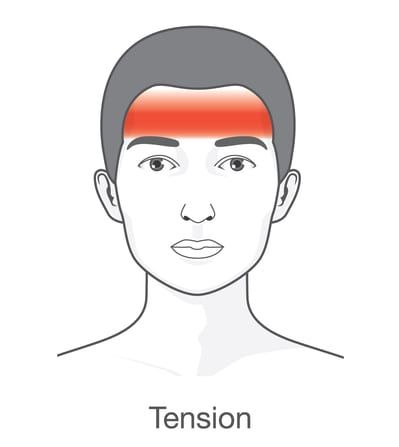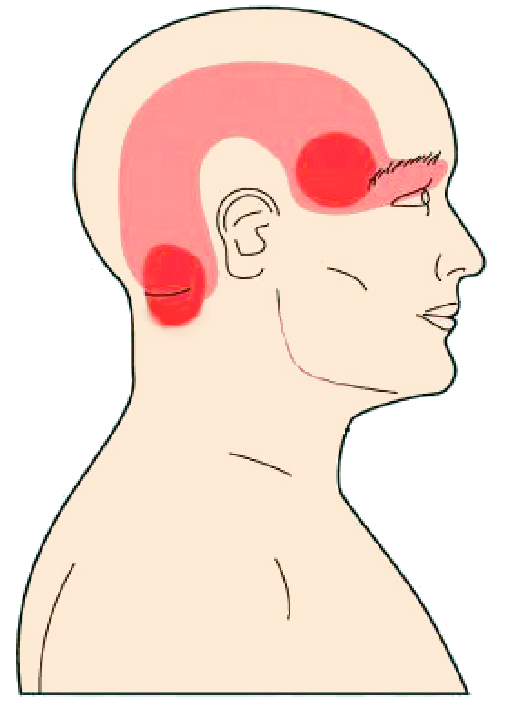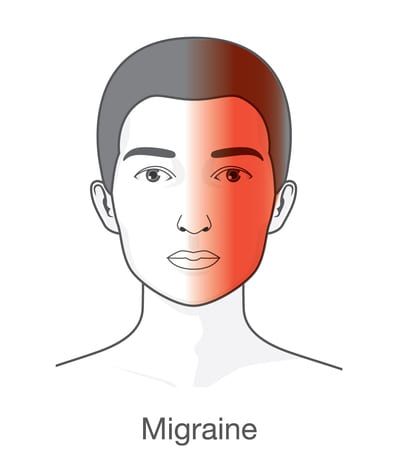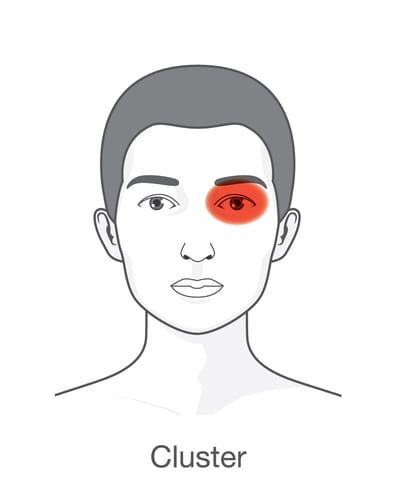Headaches can put a serious damper on your ability to enjoy your day and be productive. Did you know there is a different treatment based on which one is causing your symptoms? Consider some serious interventions to relieve your headache for good before reaching for the Advil.
Learn How to Treat Headaches
This article will focus on:
- Identifying five common headache presentations
- Understanding what is causing the symptoms
- Educating on effective treatment techniques and prevention strategies
Top 5 Headache Presentations
1. Tension Headaches

Tension headaches are often caused by contractions in the head and neck. Common triggers include poor posture, fatigue, eye strain, stress, and alcohol.
Symptoms of Tension Headaches:
- Described as a sensation of a tight band across the forehead with tenderness and sensitivity in the scalp, neck, and top of the head
- Pain present on both sides of the head
- Reported as a steady ache with slow onset
Treatment of Tension Headaches:
This is largely driven by the cause of the symptoms and can be diagnosed with a thorough evaluation with a physical therapist or chiropractor. Common recommendations include:
- Spinal manipulation
- Dry needling
- Postural exercises such as chin retractions or neck/back extensor strengthening
- Stretching of upper traps, levator scapulae, and scalenes
2. TMJ Headaches

These present similar to tension headaches. The origin tends to be related to jaw clenching, tight muscles in the face, displacement of the tempomandibular disc or abnormal jaw range of motion.
Symptoms of TMJ Headaches:
- Pain is usually felt at the top of the head, eyes, and near the jaw
- A sensation of tightness, similar to wearing a tight hat or having your hair pulled
- Noticing tenderness around jaw after sleeping or during periods of stress
Treatment of TMJ Headaches:
- Reducing jaw clenching with a night guard, relaxation exercises, awareness of response to stressful situations
- Physical therapy can provide interventions such as dry needling and soft tissue massage to relieve pain; mobilization of the jaw joint can also improve function, muscle length, and range of motion. Check out this recent blog for the most effective exercise techniques for pain relief
3. Cervicogenic Headaches

Often referred to as a “Ram’s Horn” headache due to symptom referral pattern, cervicogenic headaches are extremely common. They tend to affect individuals working a desk job or those who have situations that require prolonged sitting/posturing. These are generated by the upper neck joints and muscles, namely our suboccipitals. Think of these muscles as antennas; they create small movements of our neck and head and are extremely important in providing our brain information regarding our location and safety. If we spend a long period of time in the same position, these muscles lack motion, which trigger an “alert” (pain) referral pattern to this area to improve. Other traumatic events such as whiplash, fracture, and dislocation can cause similar pain. These often cause guarding and reduced motion.
Symptoms of Cervicogenic Headaches:
- Referral pattern is usually seen on one side, starting in the neck and coming up around the ear to the temple region (like a ‘ram’s horn’)
- Pain is described as tender, aching, or dull
- Reduced flexibility of the neck
Treatment for Cervicogenic Headaches:
If identified, a physical therapist can help put an end to these utilizing the following:
- Spinal manipulation, specifically of the upper cervical joints
- Dry needling to relieve muscle tension
- Mobilizing and improving range of motion of the upper neck with retractions and flexion of these joints
- Utilizing a SNAG strap can provide as a useful tool to self-mobilize rotation at home (see below)
4. Migraine Headaches

This may be one of the more debilitating headaches on the list and is usually diagnosed by exclusion and/or symptom presentation. It is considered a neurological condition. Common triggers include: skipping meals, caffeine withdrawal, sleep deprivation, anxiety/stress, and genetics.
Symptoms of Migraine Headaches:
- Pain is often described as pulsatile in nature
- Covering one side of the face or neck
- Sensitivity to light, sound, and visual changes (referred to as an “aura,” including blind spots, flashing lights, stars etc.)
- Nausea and vomiting may occur
Treatment of Migraine Headaches:
Given the complexity of the symptoms and various causes, a physician may be consulted to allow for appropriate interventions to be implemented. This may include the following:
- Lifestyle modification: stress management, acupuncture, meditation
- Medications to relieve symptoms that are migraine-specific, anti-nausea, and NSAIDs
5. Cluster Headaches

These tend to be more rare and diagnosed by exclusion and symptom presentation as well. This can be quite debilitating and extremely painful.
Symptoms of Cluster Headaches:
- Pain is described as throbbing and stabbing, specifically around the eye or temporal region on one side of the face
- Autonomic symptoms accompany the pain and may include the following: nasal congestion, eye tearing, eyelid swelling or drooping, forehead or facial sweating and flushed skin on one side of the face
- Migraine-like symptoms include sensitivity to light and sound and nausea or vomiting
Treatment of Cluster Headaches:
Identifying triggers can be a powerful tool in managing symptoms. Vasodilation has been known to generate a new onset of cluster headaches. Other notable activities that cause an event may include:
- Abrupt change in sleeping habits
- Alcohol
- Prolonged anxiety
Avoiding the triggering behaviors above may help prevent onset. Exercise has also been shown to improve symptoms as this induces vasoconstriction. Preventive medications such as verapamil can be also useful if prescribed by a physician.
How to Stop Headaches from Ruining Your Day

Hopefully, this will lend insight into the variety of headaches that may occur and aid in the selection of treatment best suited to solve your symptoms. Physical therapy can be an excellent tool in the conservative yet effective management of headaches. Avoiding overuse of prescription medications, opioids, or surgery is the overall goal.
At Onward, we specialize in identifying the type of headaches as well as utilizing skills such as manual therapy, dry needling, spinal manipulation, and strengthening in the overhead position to help you get rid of headaches for good. Don’t wait, schedule an appointment today!
Recent Articles
Why Early Intervention Physical Therapy Accelerates Your Recovery

What to Expect at Your First Physical Therapy Session?

How to Choose a Physical Therapist

The Top 5 Misconceptions About Physical Therapy

The Complete Guide to Physical Therapy

